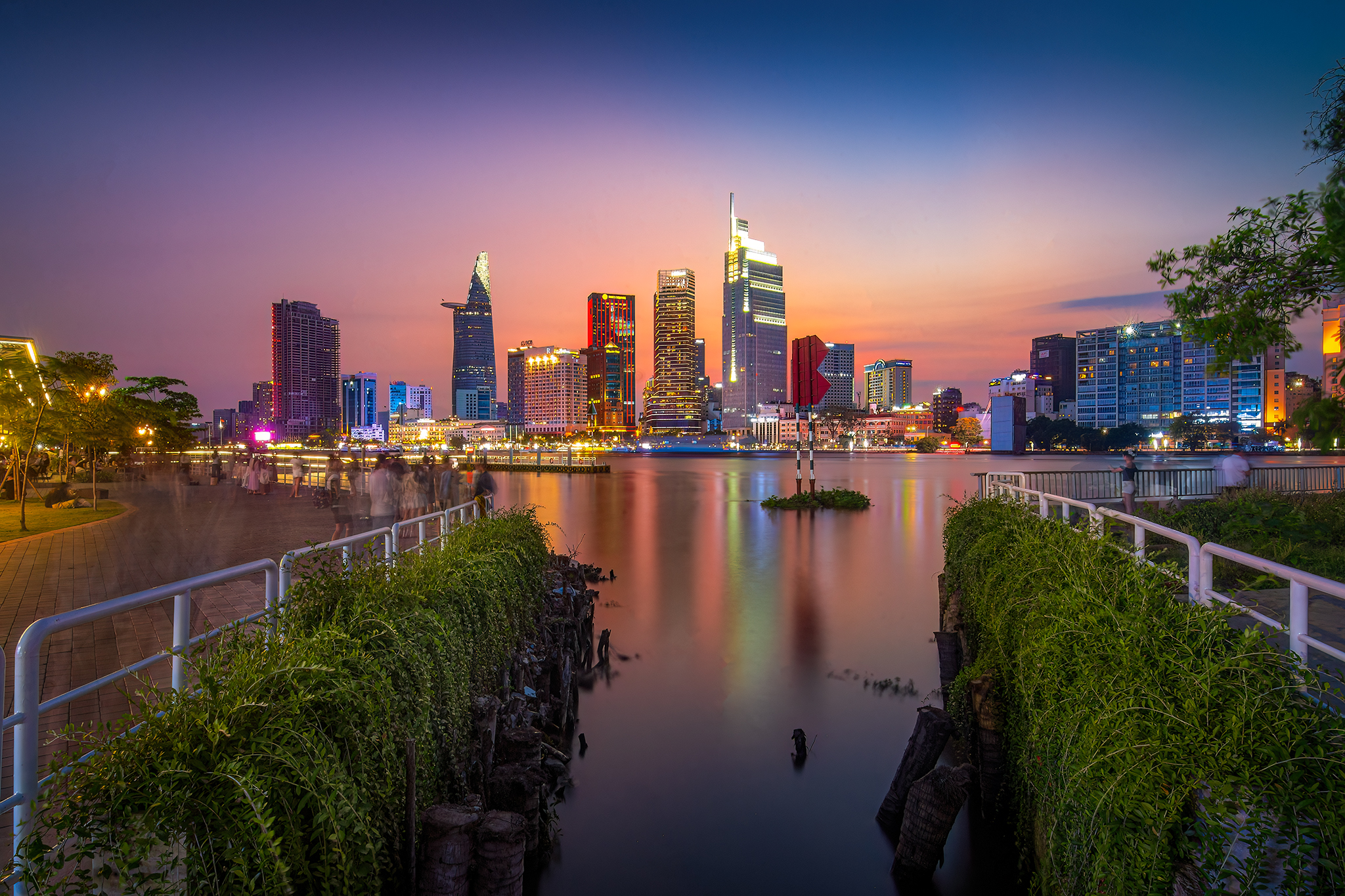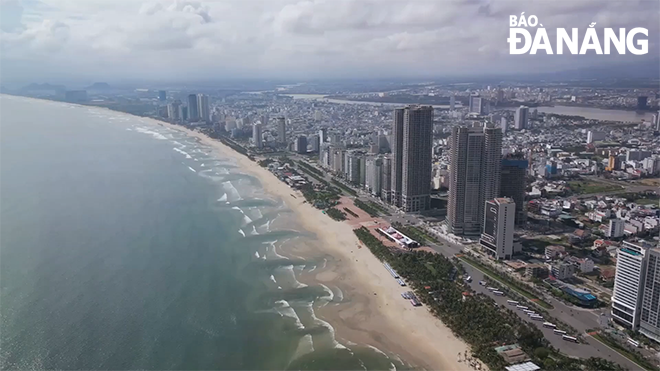Awakening Da Nang agricultural tourism
There has been a long journey with many experiments, but there are still quite a few investment projects in agritourism (tourism associated with agriculture) that have created success and attraction. Not only that, the goal of shaping products, connecting and building tours with other Da Nang tourism products still needs attention when this is a much favoured tourism trend. Many tourists love it, while agricultural resources still have plenty of room to exploit effectively.
 |
| The Yen Retreat is a popular agricultural tourism site. Photo: NVCC |
Green, beautiful rest stops
Located about 17km northwest of the city center, the BaNa Rita Farm, an eco-tourism area with the rustic space, is located on Hoang Van Thai Street, connecting with Ba Na - Suoi Mo tourist area. The BaNa Rita Farm is considered by travel connoisseurs to be an ideal stopover when they want a peaceful entertainment space blending with nature in a peaceful, poetic setting and separate from crowded, noisy streets.
Coming into operation from 2022, Bana Rita Farm is one of the professional eco-tourism areas with a quite new organisation method. The story of the journey to establish Bana Rita Farm says many things about the current situation of using agricultural land resources in Hoa Vang District. The rains in early November seem to add vitality to the trees, grass and even the herds of livestock (sheep, chickens and ducks) at the Bana Rita Farm. Along the small concrete road, which the builder intentionally created to be softer with sharp curves, gardeners are seen patiently digging the soil to plant more rows of trees.
According to the revelation made by Mr. Le Thanh Tuan, the Bana Rita Farm’s owner, the most important turning point for this land was in the 2010s, when his parents trusted him with 5 hectares of agricultural land located in Hoa Phu Commune used to grow acacia, the main tree variety that brought economic value in the mountainous area of Hoa Vang District at that time. After only a few years of care, the acacia garden brought initial profits to Mr. Tuan and his wife.
From here, the idea of forming an eco-tourism area began to emerge. After accumulating a decent amount of capital, he, along with his wife and their friends, aimed for a longer-term goal and officially began building the Bana Rita Farm.
Before that, he consulted the reality of building models in a few ecotourism areas and destinations in Da Nang as well as in Da Lat, Ho Chi Minh City and a number of western provinces and cities, and the Mekong Delta.
Finally, the plan to build a resort combined with agricultural experience is finalised based on the advantages of the Hoa Phu land, which is growing clean vegetables, forming fruit gardens with tree species suitable for the soil such as green grapefruits, mangoes and star apple. Mr. Tuan and his wife also built small farm areas to raise sheep, chickens and rabbits.
The above-mentioned factors are reasonably arranged to increase the experience for tourists when coming here to have fun and relax. As soon as it went into operation, the Bana Rita Farm attracted a large number of customers including family groups, schools, agencies and units.
“Dozens of fruit trees have given their first batches of fruit. Every time I see tourists excited when they find ripe fruits from the orchard, my heart is filled with joy.”, said a gardener named Ngoc at the Bana Rita Farm.
Emerging eco-tourism areas and destinations such as the Bana Rita Farm, the An Phu Farm and the Yen Retreat are highly appreciated by the city's tourism industry when they make a difference with the advantages of natural landscapes, maintaining its pristine beauty with fruit tree forests, the sound of gurgling streams, lush green grass or the sound of roosters crowing every morning.
All of those experiences are completely true to the smooth introduction line on the official website of Bana Rita Farm: “Camping at the Bana Rita Farm, you can immerse yourself in nature and let your soul into the the poetic space, which prompts you to return to your childhood when your parents let you go camping with friends, sleep in a tent, build a fire, enjoy roasted cassava, baby corn on the stove, fresh vegetables and aromatic tomatoes, next to the guitar. Humming a few tunes, immersing yourself in counting the sparkling stars at night, regenerating positive energy”.
One of the important capital and materials that contributes to the uniqueness and uniqueness of the above-mentioned agricultural tourist areas and destinations is the integration of many specialty dishes and daily lifestyles of the Co Tu ethnic people into common space. This effort has been reviving the precious tangible and intangible cultural values of ethnic minorities, concentrated in mountainous communes of Hoa Phu and Hoa Bac.
Mr. Bui Duc Vu, the owner of the outdoor camping tourist site Yen Retreat, said that the "soul" of this place is the green lawn, spanning the entire one out of 4 hectares of agricultural land that he co-owns.
With the desire to contribute a true "rest stop" for tourists when coming to Da Nang in general, and Hoa Bac commune in particular, Mr. Vu sincerely said: "I "steered" Yen Retreat in the direction of a camping area. Unlike other campgrounds that only rent tents and sites and are self-service, I believe that when traveling, even experiential travel, you have to spend all your time having fun and enjoying things instead of worrying and being busy with cooking as usual. Coming to Yen Retreat, tourists only need to have fun, our team will take care of the rest."
 |
| The scene is still quite pristine at the Bana Rita Farm tourist area. Photo: KHANH HOA |
Free up resources from agricultural land
Expanding tourism development, especially eco-tourism and experiential tourism, is a trend chosen by a large number of tourists now and in the future. It is also considered a journey to awaken diverse resources in local mountainous areas, contributing to promoting the development of green tourism models, tourism aiming at sustainable values of natural resources. Along with the efforts exerted by localities, the systematic investment of businesses as mentioned above is gradually creating attraction, as well as affirming the position of eco-tourism and experience.
In the opinion of many businesses and investors, with this form, they do not need to invest too much in high-end items such as swimming pools, restaurants and bars because what customers are looking for is a unique, close-to-nature, rustic space. They want to personally experience the feeling of planting, watering plants, chopping firewood, cooking in a fresh, peaceful space.
Mr. Cao Tri Dung, the Chairman of Viet Nam Travel Association, Chairman of Da Nang Tourism Association, said that tourists' needs and travel trends are fundamentally changing when targeting products rich in experience, co-creation, local attachment and responsibility in sustainable development. This is an opportunity to invest specifically in community tourism and agricultural tourism.
Till date, Da Nang has initially developed a number of agricultural tourism and community tourism models to attract domestic and international tourists, contributing to improving people's livelihoods and income. The step of restructuring the rural economy towards increasing the proportion of tourism services is contributing to the development of the local economy in a green and sustainable direction.
On the basis of resources, the city's agricultural production and agricultural tourism activities are being "awakened" to unlock resources, contributing to promoting green tourism development.
Many ecotourism sites combined with resorts have been formed in Hoa Phu and Hoa Bac communes in Hoa Vang District, not only contributing to restructuring the rural economy towards increasing the proportion of the tourism and service industry but it also effectively promoting agricultural land resources, which still have plenty of room to contribute to local budgets.
The shaping of agricultural tourism also brings many benefits to both agriculture and rural people. This combination can contribute to diversifying commercial activities and solving output problems for agricultural products. Meanwhile, agricultural tours also create jobs and increase income for farmers, especially in times of "failure" or out of the harvest season.
To support the promotion of agricultural tourism and eco-tourism development, the Da Nang People's Council issued Resolution No. 82/NQ-HDND dated December 17, 2021 approving the pilot project for agricultural and forestry development combined with exploiting tourism services in Hoa Vang District in the 2022 - 2025 period.
Expressing his expectation of realising the idea of opening a large-scale showroom, promoting the consumption of OCOP products right at the Bana Rita Farm, Mr. Le Thanh Tuan said that, if implemented successfully, attracting tourists will be even more convenient. It is known that the Bana Rita Farm is one of the initial pilot projects under the Resolution 82/NQ-HDND.
Accordingly, Bana Rita Farm currently only uses 30% of the total area of 5 hectares of agricultural land, the remaining land area is used to grow fruit and ancient trees.
Meanwhile, since its official operation in 2019, the Yen Retreat tourist area has become a point of consumption of a large amount of food sources to serve the needs of tourists taken from the people themselves in Hoa Vang District.
Along with Bui Duc Vu, six other farmers have joined together to form an agriculture and tourism cooperative group, joining hands to effectively exploit, manage and preserve resources in this place.
Mr. Nguyen Thuc Dung, the Standing Vice Chairman of Hoa Vang District People's Committee, said that currently Hoa Vang has 4 models unanimously advocated and implemented by the District People's Committee on the basis of Resolution 82/NQ-HDND, of which three models that have welcomed customers and are operating stably, namely An Phu Farm, Bana Rita Farm model, both in Hoa Phu Commune and ‘Nam Yen valley vineyard’ model in Hoa Bac Commune.
All models create on-site jobs for about 25-30 local workers, helping to consume agricultural products and OCOP specialty products of the district. After a period of operation, the models have proven to integrate multi-sectors into agricultural production and help agriculture increase its value many times over.
In the coming time, the Hoa Vang District People's Committee will continue to evaluate similar projects in accordance with the principles to replicate the model effectively and serve community benefits.
Reporting by KHANH HOA - Translating by A.THU








